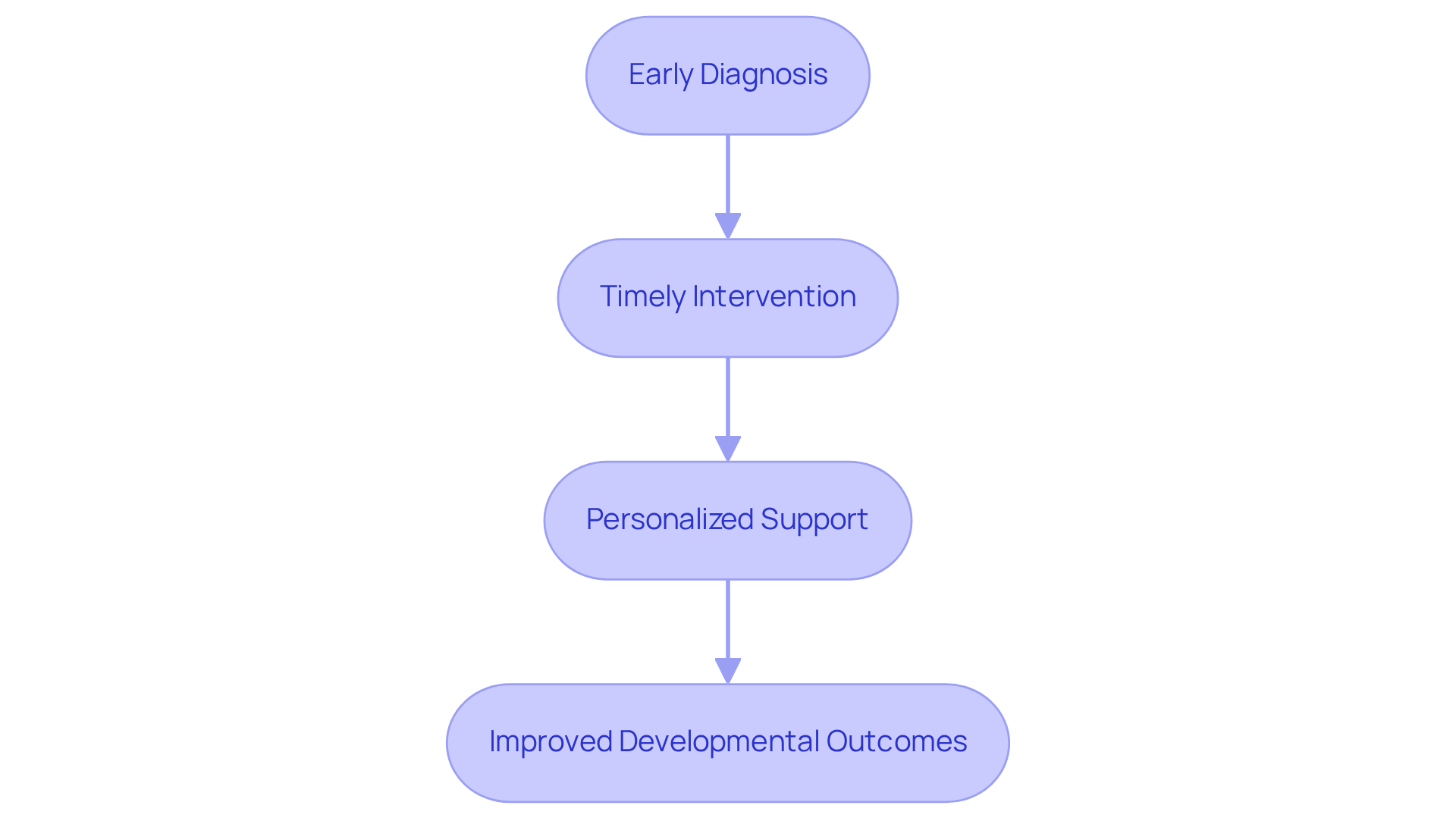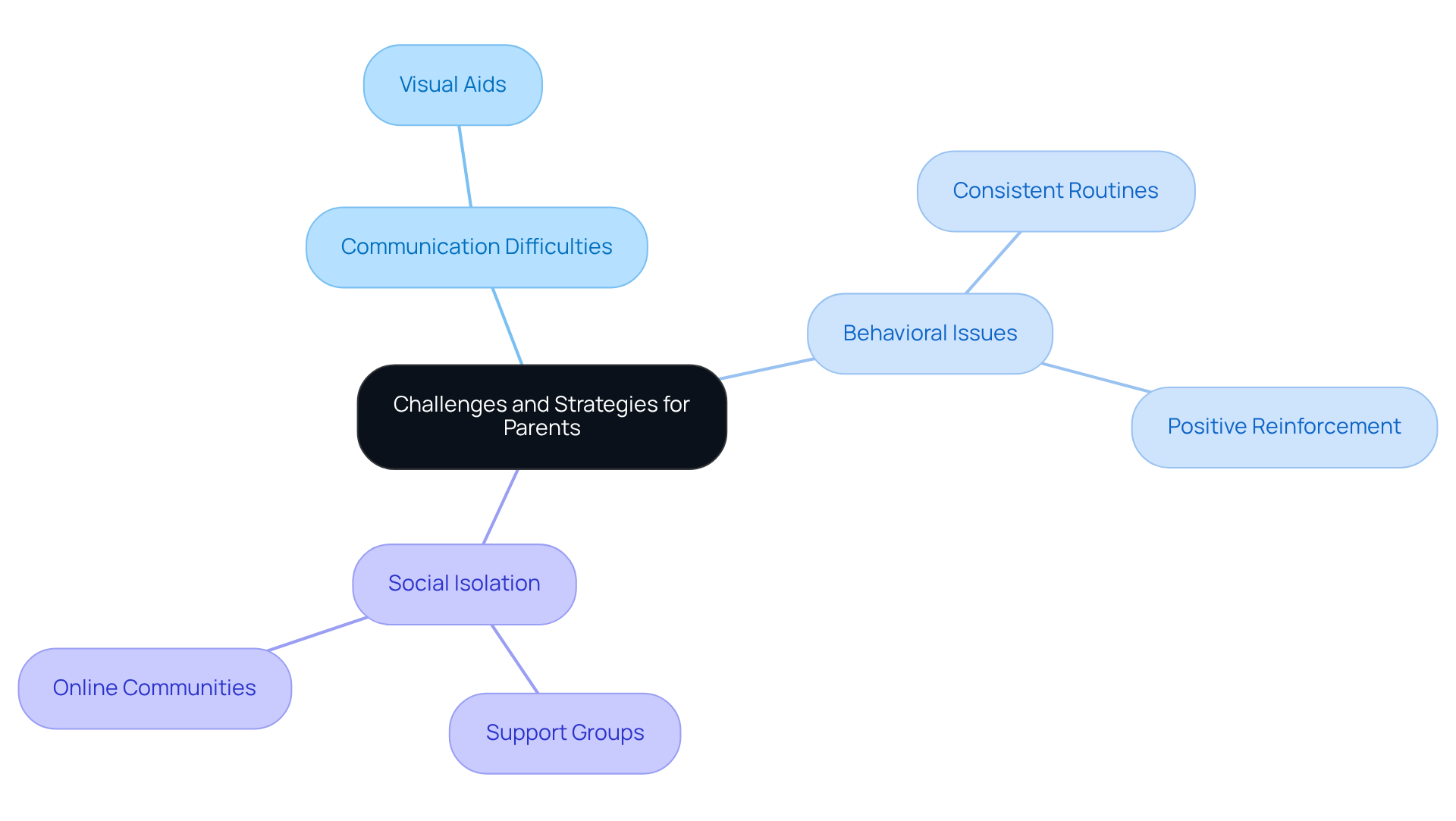Overview
This article delves into the various stages of Autism Spectrum Disorder (ASD), aiming to foster a deeper understanding that can lead to effective support for individuals at every level. Each tier, from those who require support to those needing very substantial assistance, possesses distinct characteristics and necessitates tailored strategies. It is crucial to recognize that early diagnosis and personalized interventions can profoundly enhance the quality of life for those with autism. By sharing insights and experiences, we can create a compassionate community that embraces and uplifts individuals with ASD.
Introduction
Understanding Autism Spectrum Disorder (ASD) is a journey through a complex landscape filled with varying levels of support and unique challenges. With approximately 1 in 31 children diagnosed with autism in the U.S., the urgency for effective strategies tailored to each stage of autism has never been more critical. This article explores the distinct characteristics of autism levels, underscoring the vital role of early diagnosis and personalized support in enhancing the quality of life for individuals with ASD.
How can caregivers and professionals work together to bridge the gap between understanding these stages and providing the necessary assistance to promote growth and independence? Your experiences and insights are invaluable—let's embark on this journey together.
Define Autism Spectrum Disorder and Its Levels
Autism Spectrum Disorder (ASD) is a neurodevelopmental condition that can present unique challenges in interpersonal communication and often involves restricted, repetitive behaviors. Understanding the different stages of autism and the support needed at each level is crucial for caregivers and professionals alike.
Tier 1 (Requiring Support): Individuals at this level may struggle to initiate interactions and often display rigid behaviors. They typically require some assistance to effectively navigate social situations, which can be daunting.
Tier 2 (Requiring Substantial Support): Those in Tier 2 face more significant hurdles in communication and need considerable help to engage in daily activities. This level often includes individuals who find it difficult to interpret fundamental social cues, making interactions feel overwhelming.
Level 3 (Requiring Very Substantial Support): Individuals classified under Level 3 encounter severe challenges in communication and have extreme difficulty adapting to changes in their environment. They require extensive assistance across all aspects of life, including personal care and social engagement, which can be a heavy burden for families.
Current statistics reveal that approximately 26.7% of autistic 8-year-olds in the U.S. have profound autism, necessitating lifelong care. Furthermore, 1 in 31 children in the U.S. is diagnosed with autism, underscoring the prevalence of ASD. The average age of diagnosis is 5 years, highlighting the importance of early intervention. Notably, boys are diagnosed at a rate of 43.0 per 1,000, compared to 11.4 per 1,000 for girls, emphasizing the need for tailored support strategies that consider the unique characteristics of different stages of autism.
Practical examples of effective support methods include organized social skills training for individuals in Tier 1, which can enhance their ability to engage in social interactions. For those in Tier 2, using visual schedules and maintaining consistent routines can significantly improve daily functioning. Meanwhile, individuals in Level 3 may find intensive behavioral interventions and personalized care plans particularly beneficial, addressing their specific needs.
Understanding these levels is essential for caregivers and professionals, as it enables them to customize their approaches and provide the appropriate support necessary for each individual to thrive. As the American Psychological Association states, "ABA is frequently called the 'gold standard' of ASD therapies because it instructs autistic children in the behaviors and skills essential for success in school or at work."
By fostering a supportive environment, we can help individuals with ASD flourish. What strategies have you found helpful in your journey? Share your experiences with us, as your insights could inspire others seeking guidance.

Explore Characteristics and Support Needs of Each Autism Level
Understanding the different stages of autism is crucial because each stage presents unique characteristics and specific support needs that can significantly impact individuals and their families.
Level 1 individuals may find themselves struggling with social cues, often requiring assistance with organization and planning. Support methods such as interpersonal skills training and structured routines can foster independence and improve interactions. The National Survey of Children’s Health reveals that the average age of autism diagnosis in the U.S. is 5 years, which highlights the importance of early intervention strategies for those identified at different stages of autism, specifically Level 1.
Moving to Level 2, individuals often need more explicit support in social situations. They may greatly benefit from visual aids and clear communication strategies that enhance understanding. Behavioral interventions play a critical role in reinforcing positive behaviors and encouraging engagement in social contexts. Notably, statistics show that nearly 60% of individuals with autism in the U.S. secure employment after receiving vocational rehabilitation services, underscoring the need for effective support strategies for Level 2 individuals.
For individuals at different stages of autism, especially those at Level 3, extensive assistance is essential for daily living and communication. Strategies may encompass individualized support, specialized educational programs, and consistent routines designed to manage anxiety and behavioral challenges effectively. A case study on 'Diagnosis and Early Intervention' illustrates the pressing need for improved access to early diagnosis and intervention services, which is vital for individuals at Level 3.
By recognizing these traits, caregivers can implement tailored strategies that significantly enhance the quality of life for individuals with autism. This ensures that support is not only effective but also attuned to their specific needs, fostering a nurturing environment where they can thrive.

Highlight the Importance of Early Diagnosis and Customized Support
It is crucial to diagnose the different stages of autism spectrum disorder (ASD) early. It opens the door to timely interventions that can significantly improve developmental outcomes for children. Research shows that when children are identified before the age of 2.5, they often experience remarkable advancements in communication and interpersonal skills. In fact, around 65% of these children demonstrate considerable improvements within just one to two years.
Personalized assistance tailored to each child's unique needs is vital for enhancing their ability to navigate social situations and develop essential life skills. The American Academy of Pediatrics emphasizes the importance of developmental screenings at key milestones. These screenings play an essential role in ensuring that early intervention can take place, providing the timely support that families need.
As a parent, it's important to be proactive. If you notice early signs of different stages of autism, such as delayed speech or difficulties in social interactions, seeking evaluations promptly can lead to the vital assistance your child deserves. Consider the case of a 4-year-old girl named G. Her journey illustrates the transformative power of early and tailored support for children with autism. After receiving targeted interventions, she moved from facing significant challenges to truly thriving. This story serves as a reminder of the impact that early action can have on a child's life.

Identify Common Challenges and Effective Strategies for Parents
Parents of children with autism often encounter a range of challenges that can feel overwhelming. These experiences are common, and understanding them is the first step toward finding effective support.
- Communication Difficulties are one of the most significant hurdles. Many children with autism struggle to express their needs and emotions, which can lead to frustration for both the child and the parent. To ease this challenge, parents can utilize visual aids, such as picture schedules, which can facilitate communication and help children express themselves more clearly.
- Behavioral Issues often arise as well, frequently linked to sensory overload or frustration. Implementing consistent routines and positive reinforcement strategies can make a substantial difference in managing these behaviors, creating a more harmonious environment at home.
- Social Isolation is another concern that many parents face. The unique demands of raising a child with autism can lead to feelings of loneliness. However, joining support groups or online communities can provide much-needed emotional support and practical advice, helping parents connect with others who understand their journey.
By recognizing these challenges and employing effective strategies, parents can foster a supportive environment that nurtures their child's development and well-being. Remember, you are not alone in this journey; seeking help and sharing experiences can lead to a brighter path for both you and your child.

Conclusion
Understanding the various stages of Autism Spectrum Disorder (ASD) is essential for providing effective support tailored to the unique needs of individuals. Recognizing the distinct characteristics and challenges associated with each level enables caregivers and professionals to offer the necessary assistance that fosters growth and independence. This nuanced approach enhances the quality of life for those with autism and empowers families to navigate their journeys with confidence.
Throughout this article, we have shared key insights regarding the three tiers of autism:
- Tier 1, which requires support
- Tier 2, needing substantial support
- Level 3, demanding very substantial support
Each tier presents specific challenges, from communication difficulties to severe behavioral issues, underscoring the importance of early diagnosis and intervention. By implementing targeted strategies—such as social skills training, visual aids, and consistent routines—caregivers can significantly improve the developmental outcomes and daily experiences of individuals with ASD.
The significance of early diagnosis cannot be overstated, as timely interventions can lead to remarkable advancements in communication and social skills. As families and professionals work collaboratively, it is crucial to remain proactive in seeking evaluations and support. By sharing experiences and strategies, we can foster a community of understanding, ultimately leading to a more inclusive environment where individuals with autism can thrive. Embracing this journey together not only enriches lives but also builds a foundation for a brighter future for all involved.
Frequently Asked Questions
What is Autism Spectrum Disorder (ASD)?
Autism Spectrum Disorder (ASD) is a neurodevelopmental condition characterized by challenges in interpersonal communication and often involves restricted, repetitive behaviors.
What are the different levels of support needed for individuals with autism?
There are three levels of support needed for individuals with autism: Tier 1 (Requiring Support): Individuals may struggle to initiate interactions and display rigid behaviors, needing some assistance in social situations. Tier 2 (Requiring Substantial Support): Individuals face significant communication hurdles and need considerable help with daily activities, often finding it difficult to interpret social cues. Level 3 (Requiring Very Substantial Support): Individuals encounter severe communication challenges and require extensive assistance in all aspects of life, including personal care and social engagement.
What percentage of autistic 8-year-olds in the U.S. have profound autism?
Approximately 26.7% of autistic 8-year-olds in the U.S. have profound autism, which necessitates lifelong care.
What is the prevalence of autism diagnoses in children in the U.S.?
1 in 31 children in the U.S. is diagnosed with autism, highlighting the prevalence of ASD.
At what average age is autism typically diagnosed?
The average age of autism diagnosis is 5 years, which emphasizes the importance of early intervention.
How do autism diagnosis rates differ between boys and girls?
Boys are diagnosed with autism at a rate of 43.0 per 1,000, compared to 11.4 per 1,000 for girls, indicating a need for tailored support strategies.
What are some effective support methods for individuals at different levels of autism?
Effective support methods include: Tier 1: Organized social skills training to enhance social interaction. Tier 2: Using visual schedules and maintaining consistent routines to improve daily functioning. Level 3: Intensive behavioral interventions and personalized care plans to address specific needs.
Why is understanding the levels of autism important for caregivers and professionals?
Understanding these levels is essential for caregivers and professionals as it enables them to customize their approaches and provide appropriate support necessary for each individual to thrive.




